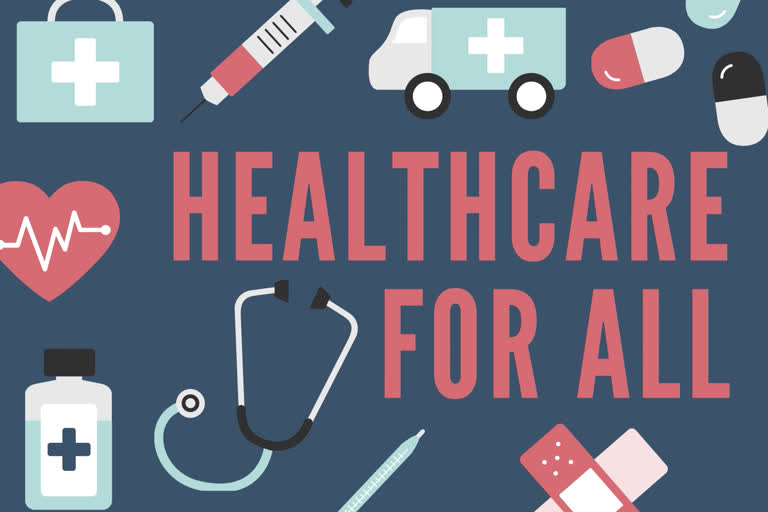Hyderabad: At a time when the health sector in India is facing several problems like shortage of doctors, hospitals, medicines and facilities, the government is only taking routine measures and not focusing on long term solutions.
As a result, the common people are battling ill health, mainly in villages, where there is no parity between the needs and facilities pertaining to the health sector.
While the World Health Organisation (WHO) suggests one doctor for 1000 people, India, in contrast, has only a doctor for 10,189 people. According to an estimation, India is facing a shortage of at least 6 lakh doctors and 20 lakh nurses.
Further, the health expenditures for the 30 crore people below the poverty line is proving to be a burden in our country.
With respect to quality health care services, India languishes at the 102nd spot among 117 nations. Significantly, our neighbouring countries like China, Bangladesh, Sri Lanka, and Bhutan occupy better spots.
India also lags behind in offering better services to patients of TB, heart-related ailments, Cancer and Kidney problems.
Astonishingly, India is one among the top 45 nations facing hunger problems in the world. A survey revealed that our children weigh 21 per cent less than the normal weight due to food shortage in the country.
Read: India needs total awareness to eradicate TB, says health expert
Shockingly, only 27 per cent of India's population has got health insurance facility. The main reason for this is that insurance companies are reluctant to provide health insurance services with less premiums to the poor and rural population. Yet another reason is the lack of awareness among people on health insurance and its advantages.
The reality is that most of the healthcare schemes by the governments are not catering to the needs of people. Poor allocation of the funds and lack of better conditions at field level are the reasons for the health problems.
The Centre had planned the National health scheme for everyone in the country in 2017, and formally launched Aayushman Bharat program on September 23 last year. It aims to provide health insurance services to all and offers Rs 5 lakh insurance amount per family. About 50 crore people were covered under this scheme across the country.
However, many feel that the scheme failed to reach its set targets. People are unable to meet their expenditures as every family has to spend about 20 to 60 per cent of its income on medicines. Keeping this in view, the Centre launched Pradhan Mantri Jan Aushadhi outlets.
Read: India's ailing Public Health Centres
The government has already opened 5000 such medical shops across the country to provide better quality medicines at affordable prices. Now, the Centre plans to set up 2500 more Jan Aushadhi shops by 2020.
Yet another sad truth is that expenditure made on health sector in the country from 2009-13 was only 0.98 per cent of the GDP. This health expenditure was eventually increased from 1.2 per cent in 2014 to 1.4 per cent in 2018. Of this, 30 per cent expenditure is on the primary health sector alone.
Significantly, developed nations spend a huge chunk of their GDP on the health sector alone. The USA spends 18 per cent of its GDP on the health sector.
It is not easy to get an answer to a question on when India can allocate such huge per cent of funds for the health sector.
Firstly, basic facilities and infrastructure have to be improved to provide better health care services. The government has to identify people below poverty line and the poorest of the poor and offer health insurance facility. The poor will sure get a reprieve if the government offers total or some premium for the health insurance coverage.
Read: 1 in 7 Indians suffered from mental health issues in 2017: Study
The problem of doctors and improved health care services can be addressed by setting up one medical college in every district.
In 2013, the percentage of elders in the country was 8 per cent. According to an estimate, it is expected to rise to 18.3 per cent by 2050. This will prove to be a major challenge for the government as most of the elderly persons are likely to face health problems by then.
Proper health services are not being offered to people in rural areas due to shortage of health care and basic facilities. In 1999, the government had introduced a special national policy giving priority for the welfare of aged people in the country. It also launched a health protection scheme for the old in 2011.
There is also need for focus on preventing health problems at a primary stage rather than in secondary stage to check the spread of the diseases.
Mere identification of health as a right of the people will not serve any purpose. Better health care services can be only offered by allocating more funds, improving facilities and infrastructure at field level and finding solutions to related issues. The centre and the state governments should work together in that direction to get better results.
Read: In this MP clinic doctors perform sterilisation operation under torchlight



